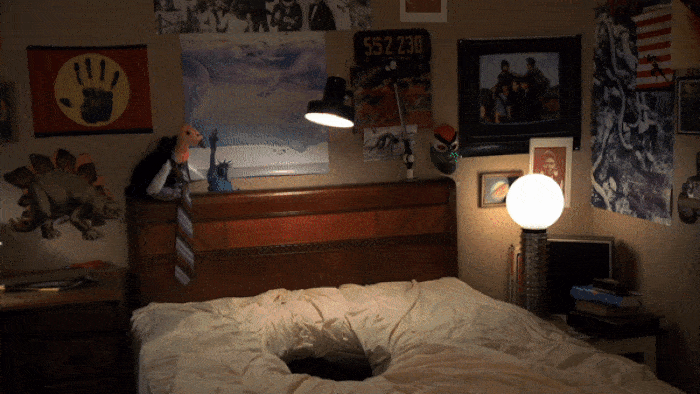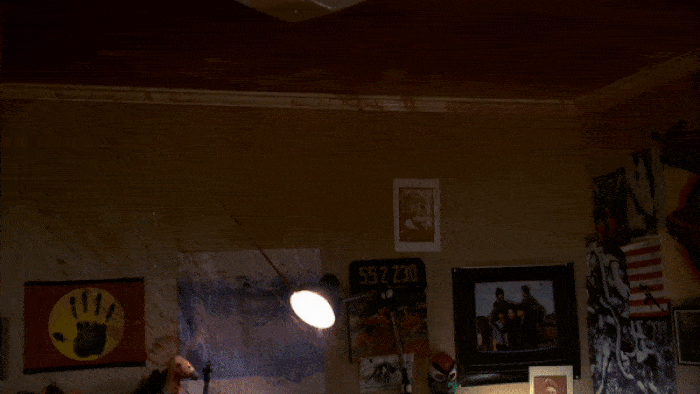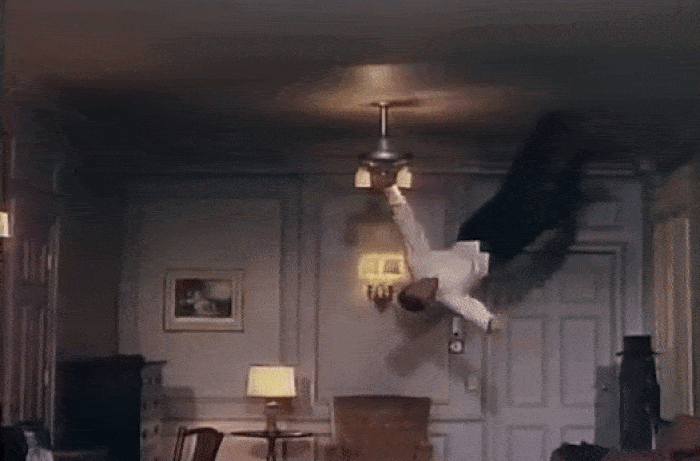Welcome to How’d They Do That? — a bi-monthly column that unpacks moments of movie magic and celebrates the technical wizards who pulled them off.
Thanks to the creative carte-blanche of its villain, the original A Nightmare on Elm Street is full of surreal practical effects. When you’re a demonic wise-guy who hunts victims in their dreams, you’re able to pull some freaky, nightmarish shit. From body bags erupting with eels to clawed hands emerging from bathtubs and stairs turning to mush, when it comes to terrorizing teens, Freddy Krueger likes to dream big.
But of all of Freddy’s dreamscape shenanigans, there’s one practical effect in Wes Craven‘s 1984 film that always leaves me in a daze. It has to do with a bed and a whole lot of blood.
Nancy (Heather Langenkamp) has learned the truth about the evil presence that’s been terrorizing her neighborhood: the spirit of a kid-killer named Fred Krueger (Robert Englund) is taking revenge on his murderers’ children by attacking them in their dreams. Nancy picks up the phone and warns her skeptical boyfriend, Glen (Johnny Depp): if he sleeps, he dies. They hatch a plan, and Nancy fixes to sneak out of her house to meet him. But her parents have put her on lockdown and escaping won’t be easy, so she gives Glen a call to loop him in. His parents pick up. He’s asleep and she ought to talk to him tomorrow. They leave the phone off the receiver. Oh god.

There’s a heavy flow joke in there somewhere.
Glen’s death is full of surprises. First, his body is sucked through the bed; a cavern forming in the mattress’ center swallowing him and his TV whole. And then the first burst of blood, more violent and propulsive than you’d expect. Who would have thought the crop-topped teen to have had so much blood in him? And it just keeps coming. Not only that, but this blood defies logic, pooling on the ceiling while the Glen-geyser keeps gushing. Finally, the blood streams unpredictably as if the room were in free fall. What a nightmare.
How’d they do that?
Long story short:
By pouring fake blood through a hole into an upside-down, rotating room.
Long story long:
Before we get to the bed geyser we have to talk about the showstopper death of Tina Gray (Amanda Wyss). Tina is the first victim of “Dream Demon” Freddy, and her demise makes one hell of an impression. While dreaming, Tina encounters Krueger (and his freaky elongated arms) in an alley and the creep sets about to teen murderin’. Meanwhile, in the waking world, Tina’s boyfriend Rod (Nick Corri) watches helplessly as Tina’s body is sliced, diced, and dragged up the wall and across the ceiling.

The wall-to-ceiling drag was accomplished with a rotating room created by mechanical special effects designer Jim Doyle (Academy Award-winning inventor of the Dry Fogger). In the essential making-of documentary Never Sleep Again: The Elm Street Legacy, Doyle explains that “Wes wanted something really big and fantastic and out there for the first death…so I suggested a rotating room.” Craven described the room as a “hairy situation,” with no wires just vertigo and panic attack-inducing rotations, with all items nailed down and the cameraman strapped into an “airplane seat” attached to the wall. The room itself was not mechanical; it took several crewmembers on either side of the contraption to manually flip the room around.
Even though it was a nightmare to shoot in, when it came time to film Glen’s death, the filmmakers went back to the rotating room. The pressure was on, not only because the blood effect was complicated (working with water always is), but because they had one take to do it. The room was flipped upside down and the crew prepared for the effect. A sheet-lined shoot for the blood was carved out of the middle of the bed, with crewmembers positioned “above” on the outside of the room, poised to pour in the gallons of blood-colored water. With the bed now positioned at the “top” of the room, Craven, strapped into a camera chair, gave the word “go.”
As cinematographer Jacques Haitkin explains in Never Sleep Again, when the crew began to dump the water through the hole “as soon as it hit the ceiling and hit the light it immediately electrified the water. So the guy pouring the water got electrocuted.” Or, as Doyle puts it: “oops.”

“Oops”
Not only was the water now electrified, but as Haitkin describes, the water began to slosh from side to side, which threw off the weight of the room, causing it to shift and the operators to lose control. The room rolled all the way over and crew members lept out of the way as cables and ropes ripped out of their rigging. As Craven recounts in the documentary, the water “went into all the lights and there were these huge flashes in the dark…we were spinning in the dark with all these sparks going on.”
The wall had a window in it and of course, the blood poured out onto the operators desperately trying to regain control of the room. The room finally stopped rocking once all the liquid poured out, leaving the crew still attached to the structure suspended, upside down, for around 20 minutes in the dark and covered in blood.

The up-is-down and vice-versa rationale of the original geyser is easy enough to wrap your head around, but thanks to the series of unfortunate events, the blood didn’t just pool on the ceiling. After the initial splash, the liquid slips and streams at angles that just don’t make sense; it’s a lurch that defies all logic. Gravity: as it exists in dreams, which is to say elusive, frustrating, and terrifyingly unpredictable. Even if they’d had the resources to do a second take, I don’t think they could have replicated the effect as it appears onscreen. And for that: a happy accident indeed.
Miraculously no one was hurt and even more miraculously…they got the shot. Fun fact: as detailed in the Larry Cohen biography Larry Cohen: The Stuff of Gods and Monsters, the cult director employed the Nightmare crew to pull off a rotating room stunt for The Stuff: “I was lucky that nobody got hurt,” Cohen explains. “But the scene looks great.” Such is the gamble of a manually operated rotating room, it seems.
What’s the precedent?
While pouring heaps and heaps of fake blood into an out of control, electrified rotating death box might be a first, Hollywood has a long and illustrious history of rotating sets. Indeed, they have been around since the early days of cinema, with gravity-defying sequences in the likes of When the Clouds Roll By (1919) and The Boat (1921).
The direct influence cited in Never Sleep Again is Stanley Donen’s Royal Wedding (1951), which features a sequence where Fred Astaire dances over every square inch of a living room. The showstopping “You’re All the World To Me” dance, which lasts a whopping four minutes, was accomplished with a cameraman harnessed inside a 20-foot-diameter rotating barrel that contained the nailed-down set. I highly recommend checking out this video from Galen Fott, which highlights Astaire’s superhuman ability to make tapdancing in a drying machine look effortless.

Fred Astaire defying gravity in ‘Royal Wedding’ (1951)
While the wheel-like interior of the Discovery spacecraft in 2001: A Space Odyssey is perhaps the most well-known example in genre cinema, rotating sets do have a particular affinity for horror. Released two years before A Nightmare on Elm Street, Tobe Hooper’s Poltergeist bares the closest family resemblance to Craven’s room effect. Both movies utilize their rooms for an identical purpose: to give the impression of an invisible, gravity-defying supernatural menace. In Poltergeist, Diane, the mother of the family, is attacked by the titular pissed-off spirit. She does some serviceable Linda Blair bed thrashing and is sent rolling up the wall, across the ceiling, and down the other side of the room.
What’s remarkable is that despite their differences in budget, Poltergeist and A Nightmare on Elm Street‘s rotating set pieces (ha!) aren’t noticeably different in a technical sense. Poltergeist‘s budget was roughly 10 times that of Nightmare‘s. That’s insane when you consider how similar the two special effects look. The budgetary constraints also explain why Nightmare had to cut corners: why their set wasn’t motorized, why they had limited takes, and why they tried to get the most out of the set as they possibly could. It’s a great example of resourcefulness and a tried-and-true, replicable cinematic special effect — a solid, simple, time-tested trick. At a certain point, throwing more money at a box in a hamster wheel is only going to pay for more set decoration. Or more blood, depending on what you’re into.




0 comments:
Post a Comment